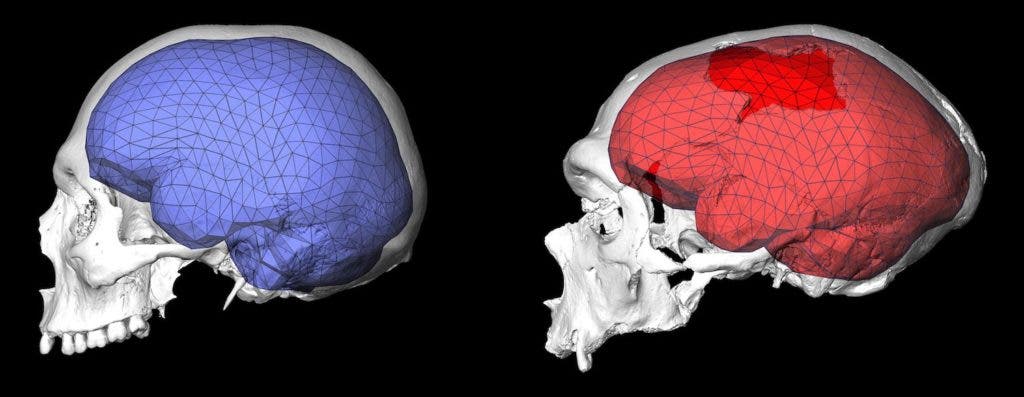Humans have been around this savannah for quite some time now — numbered in the millions of years — but ‘modern’ humans, the ones we’re used to today, have only been around for less than 200,000 years, new research suggests.

The blue brain shows the globular shape of present-day human heads. In contrast, the red skull shape of a Neandertal, like the earliest Homo sapiens fossils, is elongated.
Image credits Simon Neubauer, Jean-Jacques Hublin, Philipp Gunz / MPI EVA Leipzig.
Novel research from the Max Planck Institute for Evolutionary Anthropology, Germany, reveals that modern humans have a distinct brain and skull architecture which likely fully developed around 40,000 years ago.
Brains for days
The team used 3-D scanning technology to examine the curves, shapes, and features of 20 different Homo sapiens fossils ranging from 300,000 to 10,000 years old. Using this data, they then constructed a timeline of how our skulls (and the brains therein) changed and evolved through history.
Among other traits, they note that our skulls are rounder than our ancestors‘, our facial bones smaller and more retracted into the skull. Such changes are meant to accommodate a bigger and rounder cerebellum (the ‘little brain’ at the back of the skull, which chiefly handles motor control and balance), a beefed-up parietal lobe (which plays a part in planning, attention, and spatial orientation), and a less robust facial structure, they say.
At the same time, our brains grew in overall size, with the skull’s side walls becoming more parallel and the frontal area growing higher to accommodate the increased volume. Finally, the occipital area, at the back of the head, traded its ‘overhanging’ shape for a more rounded structure.
The authors remark that changes in modern human brain shape can be tracked almost perfectly alongside the development of what we call modern behavior. Such behavior includes multi-component tool manufacture and use, bone carving, planning, but also a wider range of cognitive processes from self-awareness, language and funeral practices, to the use of pigments and the creation of art.
This team says that these changes in size and shape occurred “at some point after about 100,000 years ago and probably before 35,000 years ago.” It wasn’t an overnight affair, but likely an addition of slight changes over tens of thousands of years. Still, it would mean that our skulls and brains were well into their new shape around the same time that the “human revolution,” a rapid emergence of modern behaviors in humans, started.
“Our new data, therefore, suggest evolutionary changes to early brain development in a critical and vulnerable period for neural wiring and cognitive development,” said the paper’s lead author, Simon Neubauer.
However, the team notes that while our brain’s rounder, fuller shape is “related to our [modern] behavior,” it’s likely not its cause.
“It is important to note that it is probably not the globular brain shape itself that is advantageous for brain function,” he adds.
“The parietal lobe is an important hub in connecting different brain regions and involved in functions like orientation, attention, sensorimotor transformations underlying planning and visuospatial integration. The cerebellum is involved in motor-related functions like the coordination of movements and balance, but also in functions like working memory, language, social cognition and affective (emotional) processing.”
The paper “The evolution of modern human brain shape” has been published in the journal Science.









